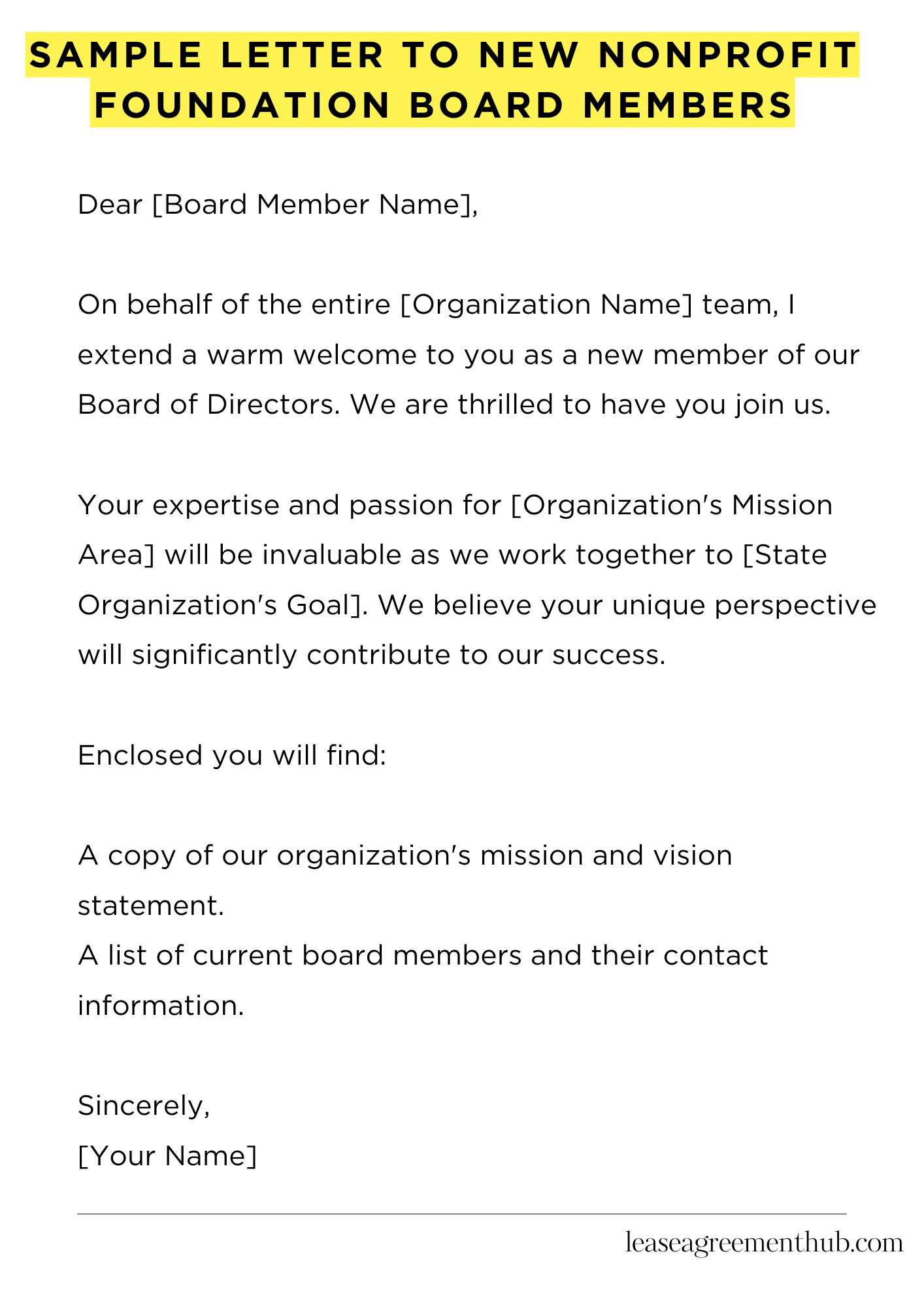A “Sample Letter To New Nonprofit Foundation Board Members” is a welcome letter. It’s sent to newly appointed board members. Nonprofits use it to formally welcome them. It’s often needed after an election or appointment.
Need to draft such a letter? You’re in the right place. We’ll share templates and examples. These samples will make your task easier.
Consider this your go-to resource. We aim to simplify the process. Get ready to craft effective welcome letters.
Sample Letter To New Nonprofit Foundation Board Members
[Your Organization’s Letterhead]
[Date]
[Board Member Name]
[Board Member Address]
Subject: Welcome to the [Organization Name] Board of Directors!
Dear [Board Member Name],
On behalf of the entire [Organization Name] team, I extend a warm welcome to you as a new member of our Board of Directors. We are thrilled to have you join us.
Your expertise and passion for [Organization’s Mission Area] will be invaluable as we work together to [State Organization’s Goal]. We believe your unique perspective will significantly contribute to our success.
Enclosed you will find:
A copy of our organization’s mission and vision statement.
A list of current board members and their contact information.
Minutes from the last board meeting.
Our strategic plan for the next [Number] years.
Our first board meeting is scheduled for [Date] at [Time] in [Location]. An agenda will follow shortly.
In the meantime, please do not hesitate to contact me or [Contact Person] at [Contact Email] or [Contact Phone Number] if you have any questions.
We are excited to begin this journey with you.
Sincerely,
[Your Name]

How to Write Letter To New Nonprofit Foundation Board Members
Subject Line: Capturing Attention from the Get-Go
- Keep it concise: Aim for under 10 words. Brevity is your ally.
- Indicate purpose: “Welcome to the Board” or “Introduction and Onboarding” works wonders.
- Avoid vagueness: Ditch the generic “Important Information.”
Salutation: Setting a Cordial Tone
- Personalize it: “Dear [Board Member’s Name]” is the gold standard.
- Address professionally: Use titles like “Dr.” or “Professor” if applicable.
- Avoid overly casual greetings: “Hey [Name]” is a no-go.
Introduction: Briefly Introducing Yourself and Your Role
- State your name and title: Clarity is paramount.
- Briefly describe responsibilities: “As Executive Director…”
- Express enthusiasm: Convey genuine excitement for their involvement.
Body Paragraph 1: Welcoming and Acknowledging Their Commitment
- Express gratitude: Acknowledge their willingness to serve. Their commitment is invaluable.
- Highlight the organization’s mission: Reinforce its importance.
- Briefly mention recent achievements: Showcase impact.
Body Paragraph 2: Providing Essential Information and Resources
- Outline key documents: Board handbook, strategic plan, financials.
- Include links or attachments: Facilitate easy access.
- Mention upcoming meetings: Dates, times, and location (physical or virtual).
Body Paragraph 3: Encouraging Engagement and Communication
- Invite questions: Foster an open dialogue.
- Provide contact information: Make yourself readily available.
- Suggest a preliminary meeting: Offer personalized onboarding.
Closing: Reinforcing Gratitude and Anticipation
- Reiterate appreciation: Gratitude is never superfluous.
- Express optimism: Look forward to their contributions.
- Use a professional closing: “Sincerely” or “Best regards.”
- Include your name and title: Ensure clarity and professionalism.
Frequently Asked Questions: Sample Letter to New Nonprofit Foundation Board Members
This section addresses common inquiries regarding the creation and purpose of a sample welcome letter for new board members.
It aims to provide clarity and guidance on crafting an effective communication.
What is the primary purpose of a welcome letter to new board members?
The primary purpose is to formally welcome new members, express gratitude for their commitment, and provide essential information about the organization and their role.
What key information should be included in the letter?
The letter should include a warm welcome, an overview of the organization’s mission and values, board member responsibilities, contact information for key staff, and details about upcoming meetings or events.
How formal should the tone of the letter be?
The tone should be professional and welcoming, reflecting the organization’s culture while maintaining a level of formality appropriate for board-level communication.
Should the letter include any specific action items for the new board member?
Yes, the letter can include action items such as reviewing specific documents, attending an orientation session, or contacting a mentor board member.
What is the best way to deliver the welcome letter?
The letter can be delivered via email, postal mail, or a combination of both. Consider including a physical welcome packet with relevant documents for a more personal touch.
Related: